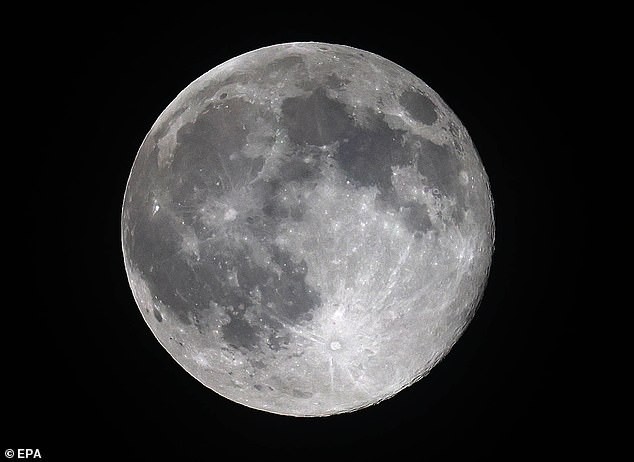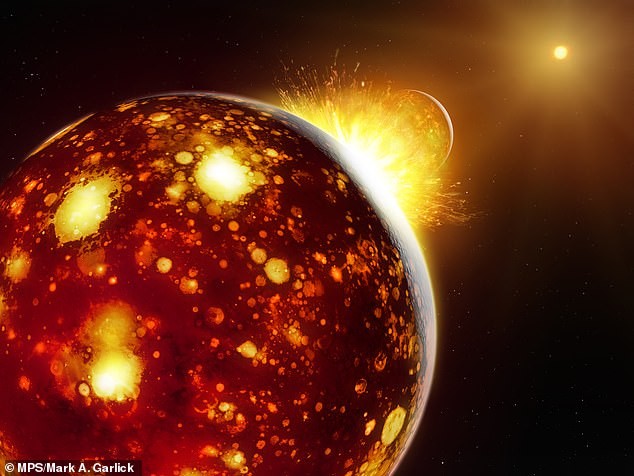Earth Had a Secret Neighbor and the Moon Was Born From That Hidden World
Scientists have proposed a shocking new theory for the origin of the moon, and their calculations suggest Earth once had a secret world hiding right next door. Astronomers believe that the moon was formed 4.5 billion years ago when a Mars–sized object called Theia smashed into Earth. Theia was completely destroyed in the collision and only remains as traces of minerals in Earth's crust and the moon. Lead author Dr Timo Hopp told Daily Mail: 'Theia was likely one of tens to hundreds of planetary embryos that collided to form the planets.' Dr Hopp suggests that Theia was once on a stable orbit within the inner solar system, sitting just closer to the sun than Earth is today. That means, for the first 100 million years of the solar system's existence, Earth had a hidden neighbour that has now totally vanished. When Theia collided with the Earth, all the material that survived the impact was swallowed up into the Earth or the moon. If any debris did escape, it was shot out of a stable orbit and has long since disappeared beyond the reach of scientific study. So, even though scientists are confident Theia did exist, it's proven extremely difficult to work out what it would have been like. However, all the material in the solar system today still holds clues about its origin. Isotopes are variants of elements that have different numbers of neutrons in their atomic nucleus. In archaeology, researchers look at the levels of these isotopes, such as Carbon 14, in the process of carbon dating to work out the age of biological material. In astronomy, scientists are able to make use of a similar process. When the solar system formed, the isotopes of the various elements weren't distributed evenly. Researchers think the moon was formed when a Mars–sized planet named Theia hit ancient Earth. During the collision, Theia and proto–Earth mixed together to create our planet and the moon. Astronomers have long suspected that the moon was created when a giant protoplanet called Theia struck the newly formed Earth – a theory first put forward in the 1970s. It says the huge collision created a vast cloud of debris, which coalesced into the moon. However, until now, astronomers have not been able to explain how this left the moon and Earth chemically identical. Later, two hypotheses arose that could explain why the moon is Earth's chemical clone, but they predict radically different masses for Theia. In one scenario, two half–Earths merged to form the Earth–moon system. But the second hypothesis suggests Theia was a small, high–velocity projectile that smacked into a large and fast–spinning young Earth. That means rocks in the outer reaches of the solar system have a different ratio of isotopes to those found closer to the sun. In their paper, published in the journal Science, Dr Hopp and his co–authors used this fact to work out where Theia might have formed. They took extremely precise measurements of the iron isotopes in rocks from the Earth, moon rocks brought back by the Apollo missions, and several asteroids. This revealed that the moon and Earth had identical ratios of iron isotopes, matching what had previously been found for other elements. The samples' similarity means that Theia and proto–Earth must have mixed together so thoroughly that they became indistinguishable. Unfortunately, this makes it impossible to work out how much of Theia ended up in the moon and how much became a part of Earth. 'The similar isotopic composition makes it also impossible to directly measure the initial composition of Theia,' says Dr Hopp. However, the researchers were able to work this out indirectly by comparing the moon and Earth to meteorites from different parts of the solar system. Scientists now say that Theia likely formed in the inner solar system, and existed on a stable orbit just closer to the sun than Earth (file photo). By looking at the composition of the Earth and moon today, the researchers looked at the different scenarios that could have led to this situation. If Theia were similar to meteors that formed in the cooler outer edges of the solar system, proto–Earth would have needed to have a totally improbable mix of isotopes. Instead, both Theia and the proto–Earth were most likely made out of rocky 'non–carbonaceous' meteors from the innermost regions of the solar system. Theia would have orbited the sun for around a hundred million years before the gravitational pull of Jupiter knocked it from its orbit and sent it careening into Earth. Dr Hopp says: 'It was on a relatively stable orbit around the Sun. We infer that this must have been closer to the Sun than Earth, however, that is all we can say.' About 4.45 billion years ago, 150 million years after the solar system formed, Earth was hit by a Mars-size object called Theia. The collision created the moon, but debate has raged exactly what happened during this event - and a mystery has persisted on why the moon and Earth are so similar in their composition. The impact of Theia with Earth was so violent, the resulting debris cloud mixed thoroughly before settling down and forming the moon. This cloud would have been composed of some Earth material, explaining the similarity between Earth and the moon, and other material. The colliding body is sometimes called Theia, after the mythical Greek Titan who was the mother of Selene, the goddess of the Moon. But one mystery has persisted, revealed by rocks the Apollo astronauts brought back from the moon - why are the moon and Earth so similar in their composition? Several different theories have emerged over the years to explain the similar fingerprints of Earth and the moon. Perhaps the impact created a huge cloud of debris that mixed thoroughly with the Earth and then later condensed to form the moon. Or Theia could have, coincidentally, been isotopically similar to young Earth. A third possibility is that the moon formed from Earthen materials, rather than from Theia, although this would have been a very unusual type of impact.

Theia’s Inner Solar System Birthplace and Hidden Orbit
Researchers from the Max Planck Institute say they uncovered Theia’s mysterious origins by looking carefully at the ratios of minerals in the Earth and the moon. By looking carefully at the ratios of minerals in the Earth and the moon, researchers have worked out where Theia likely formed. Lead author Dr Timo Hopp told Daily Mail: 'Theia was likely one of tens to hundreds of planetary embryos that collided to form the planets.' Dr Hopp suggests that Theia was once on a stable orbit within the inner solar system, sitting just closer to the sun than Earth is today. That means, for the first 100 million years of the solar system's existence, Earth had a hidden neighbour that has now totally vanished. When Theia collided with the Earth, all the material that survived the impact was swallowed up into the Earth or the moon. If any debris did escape, it was shot out of a stable orbit and has long since disappeared beyond the reach of scientific study. So, even though scientists are confident Theia did exist, it's proven extremely difficult to work out what it would have been like. However, all the material in the solar system today still holds clues about its origin.

Isotopic Clues Point Theia's Birthplace to the Inner Solar System
Isotopes are variants of elements that have different numbers of neutrons in their atomic nucleus. In archaeology, researchers look at the levels of these isotopes, such as Carbon 14, in the process of carbon dating to work out the age of biological material. In astronomy, scientists are able to make use of a similar process. When the solar system formed, the isotopes of the various elements weren't distributed evenly. Researchers think the moon was formed when a Mars–sized planet named Theia hit ancient Earth. During the collision, Theia and proto–Earth mixed together to create our planet and the moon. Astronomers have long suspected that the moon was created when a giant protoplanet called Theia struck the newly formed Earth – a theory first put forward in the 1970s. It says the huge collision created a vast cloud of debris, which coalesced into the moon. However, until now, astronomers have not been able to explain how this left the moon and Earth chemically identical. Later, two hypotheses arose that could explain why the moon is Earth's chemical clone, but they predict radically different masses for Theia. In one scenario, two half–Earths merged to form the Earth–moon system. But the second hypothesis suggests Theia was a small, high–velocity projectile that smacked into a large and fast–spinning young Earth. That means rocks in the outer reaches of the solar system have a different ratio of isotopes to those found closer to the sun. In their paper, published in the journal Science, Dr Hopp and his co–authors used this fact to work out where Theia might have formed. They took extremely precise measurements of the iron isotopes in rocks from the Earth, moon rocks brought back by the Apollo missions, and several asteroids. This revealed that the moon and Earth had identical ratios of iron isotopes, matching what had previously been found for other elements. The samples' similarity means that Theia and proto–Earth must have mixed together so thoroughly that they became indistinguishable. Unfortunately, the researchers were able to work this out indirectly by comparing the moon and Earth to meteorites from different parts of the solar system. Scientists now say that Theia likely formed in the inner solar system, and existed on a stable orbit just closer to the sun than Earth (file photo). By looking at the composition of the Earth and moon today, the researchers looked at the different scenarios that could have led to this situation. If Theia were similar to meteors that formed in the cooler outer edges of the solar system, proto–Earth would have needed to have a totally improbable mix of isotopes. Instead, both Theia and the proto–Earth were most likely made out of rocky 'non–carbonaceous' meteors from the innermost regions of the solar system. Theia would have orbited the sun for around a hundred million years before the gravitational pull of Jupiter knocked it from its orbit and sent it careening into Earth. Dr Hopp says: 'It was on a relatively stable orbit around the Sun. We infer that this must have been closer to the Sun than Earth, however, that is all we can say.' About 4.45 billion years ago, 150 million years after the solar system formed, Earth was hit by a Mars-size object called Theia. The collision created the moon, but debate has raged exactly what happened during this event - and a mystery has persisted on why the moon and Earth are so similar in their composition. The impact of Theia with Earth was so violent, the resulting debris cloud mixed thoroughly before settling down and forming the moon. This cloud would have been composed of some Earth material, explaining the similarity between Earth and the moon, and other material. The colliding body is sometimes called Theia, after the mythical Greek Titan who was the mother of Selene, the goddess of the Moon. But one mystery has persisted, revealed by rocks the Apollo astronauts brought back from the moon - why are the moon and Earth so similar in their composition? Several different theories have emerged over the years to explain the similar fingerprints of Earth and the moon. Perhaps the impact created a huge cloud of debris that mixed thoroughly with the Earth and then later condensed to form the moon. Or Theia could have, coincidentally, been isotopically similar to young Earth. A third possibility is that the moon formed from Earthen materials, rather than from Theia, although this would have been a very unusual type of impact.

